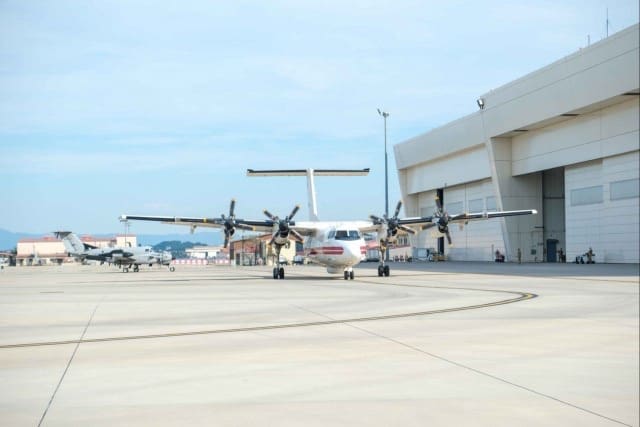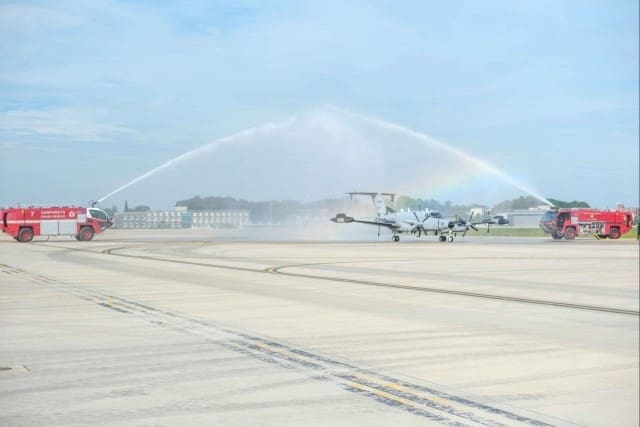
CAMP HUMPHREYS, Korea — The 501st Military Intelligence Brigade-Theater (MIB-T) observed the closure of the U.S. Army’s two most distinguished aerial intelligence, surveillance and reconnaissance (ISR) legacies, GUARDRAIL and Airborne Reconnaissance Low (ARL) during events, July 30-31, 2025.
In an event designated Operation PACIFIC SUNSET, the 501st MIB-T hosted a commemorative ceremony at the Desidario Army Airfield that featured a final flight of the aerial platforms, exhibition flights, and a runway display of aircraft. Soldiers of the Republic of Korea concluded the ceremony with a dedication honoring the contributions of the 3rd Military Intelligence (MI) Battalion, ARL, and GUARDRAIL Common Sensor (GRCS).
Since 1975, GUARDRAIL has provided indications and warnings to United States Forces Korea. Throughout its operational history, GUARDRAIL monitored the Demilitarized Zone (DMZ) through a series of diplomatic crises on the peninsula. In 1988, under the 3rd MI Battalion, the first version of GRCS entered service, ensuring foreknowledge of any aggressive actions across the DMZ for many years to come.

“[GUARDRAIL] is our longest serving U.S. Army ISR asset in the [Korean Theater of Operations], and our only true [program of record] aircraft,” said Lt. Col. Derrick J. Zantt, commander of the 3rd MI Battalion.
At the program’s high point, GUARDRAIL aircraft and ground stations became standard, serving in six aerial MI battalions. Each iteration, at its debut, was on the cutting edge of technology.
By the 1990s, the U.S. Army Intelligence and Security Command (INSCOM) had gained considerable experience in the development and fielding of special electronic mission aircraft. ARL emerged out of a shift in national priorities toward counterdrug smuggling, primarily out of the Andean Ridge region of South America. Originally a quick reaction capability, ARL was developed to satisfy low intensity multi-intelligence requirements in U.S. Southern Command and quickly proved its worth.
When the Army decided to retire the OV-1D Mohawks, the service looked to DoD and Congress for a solution.
“JSTARS couldn’t do it. The Air Force U-2 couldn’t do it. Even satellites couldn’t do it,” said Dr. Thomas Hauser, U.S. Army Intelligence and Security (INSCOM) historian and author of the INSCOM aviation book series. “INSCOM came through at the last minute with a solution: the versatile ARL. Their ever-watchful eyes stayed open all these years. It was always on the flightline or in the air, ready to serve the Army.”

During five decades of service, GUARDRAIL and ARL flew over 120,000 hours of support, over 30,000 sorties, and were flown by more than 800 military pilots through the 3rd MI Battalion over the life of the systems.
The final flights of these aerial intelligence platforms come as the Army transitions to more modern and lethal assets.
“Through the end of [its] life, the aircraft continued [its] operational collection mission until the last day and were able to effect a seamless handoff to the ATHENA program, which is serving as our bridge,” said Col. Brian Tinklepaugh, 501st MI Brigade-Theater commander.

The Army Theater-level High-altitude Expeditionary Next Airborne (ATHENA) platform combines multiple intelligence disciplines into a singular platform, enabling the Army to have a multi-intelligence approach to targets where the Army can use geospatial intelligence, signals intelligence, and electronic intelligence to look at a single target and better define that target for operational commanders.
“These bridge aircraft will continue to inform HADES programmatic requirements, facilitate early implementation of new training concepts and fielding strategies, and ultimately ensure “No Cold Starts” for the HADES program,” said Jordan Rubin, chief, INSCOM G3 ISR Operations.
The Army’s shift to the High Accuracy Detection and Exploitation System (HADES) marks a pivotal step in the future of aerial intelligence. HADES is a crewed aerial multi-intelligence collection system optimized for active campaigning in areas where range, speed, and data convergence are critical to rapidly gain and maintain situational understanding, freedom of maneuver, overmatch, and decision advantage in multi-domain operations. The system will employ on-board data processing using artificial intelligence and machine learning and will provide sensor-to-shooter links to shorten the kill chain to operate at the tempo and volume of high-intensity conflict.
HADES replaces legacy platforms such as GUARDRAIL and ARL and gives commanders the ability to see deeper, decide faster, and strike more effectively across multiple domains. As large-scale combat operations grow more complex, HADES and other strategic aerial assets will be central to ensuring U.S. forces maintain overmatch and decision advantage on the battlefield.
“As we move forward to the Army’s aerial future with HADES, I’m incredibly proud of not just the [legacy] aircraft, but the men and women who have flown the aircraft, maintained the aircraft, and who have provided that intelligence watch over more than five decades,” said Tinklepaugh.
By Erin Rohn





























































































































